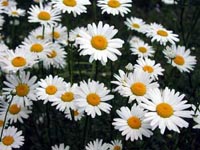Resource Library
Plant of the Week: Oxeye Daisy
The University of Arkansas System Division of Agriculture does not promote, support or recommend plants featured in "Plant of the Week." Please consult your local Extension office for plants suitable for your region.
Plant of the Week
Oxeye Daisy
Latin: Leucanthemum vulgare

Truth and honesty are treasured in any society, but are they ever elusive. All truth is tainted with the tint of our own experience and belief system. Everything we do is marked by this reality, even how we view plants.
Perhaps the oxeye daisy - the original "she loves me, she loves me not flower" is the biggest truth-teller or liar of the flowery kingdom - and a good case study for exploring this issue of truth, or at least one version of the truth.
Oxeye daisy (Leucanthemum vulgare) is the familiar roadside wildflower (or weed) that grows as a short-lived perennial in sunny places throughout most of the nation. Originally introduced from Europe, it has expanded its range throughout the country. The 2-inch wide, white daisy flowers are produced atop a slender stem that is usually around 2 feet tall.
Seldom appearing alone, oxeye daisies bloom en mass during early May where they may cover the roadsides or pastures. To the range scientist they are noxious weeds, because cattle shun them.
One common name for this plant is "poor-land daisy," a stinging commentary on the management practices used on the ranch. Over grazing to the point where grass stands are threatened opens bare ground for weed invasion, including oxeye daisy.
To the motorist, they are lovely wildflowers. If truth is to be decided by popular vote, then oxeye daisies are wildflowers, for motorists outnumber ranchers. Gardeners view it as a weedy wildflower, tolerating it or ripping it up more or less as the mood strikes.
But even this view is simplistic, because a subset of drivers and gardeners are becoming plant xenophobes, abhorring anything not native. Their version of the truth is that this alien invader, along with all its alien kinsmen, should be driven from our shores to allow the pristine reemergence of our native flora.
This issue of truth, oxeye daisy and the American way can be traced back to the founding of our country. America’s first great botanist was John Bartram (1699-1777), a Quaker farmer turned naturalist, who collected plants throughout much of eastern North America and provided Europeans - especially wealthy English patrons - plants for their gardens.
The most often quoted inspiration for Bartram’s love of botany is attributed to a report written by a fellow farmer, J. Hector St. John de Crevecoeur (1735-1813), who published a series of letters commenting on his experiences during the time leading up to the American Revolution. He tells of a visit to Bartram’s Pennsylvania farm where the botanist recounts his decision to become a botanist was spurred by a rest break from plowing, when he took the time to examine a daisy flower closely.
The letter is remarkably detailed, but at least in my interpretation of truth, likely a literary invention to fill the gaps in his story. Crevecoeur’s letters were published in English newspapers to give an account of life in the colonies, so the need to tell a proper story was probably more important than accuracy.
In 1764, Bartram told his main English sponsor he was bitten by the botany bug as a 10-year-old boy. William Bartram, also a botanist, did a brief biographical sketch of his father in 1804 and attributed his interest in the medicinal properties of plants as the main motivator. Perhaps all stories are true, perhaps none. The truth is like that.
Should you grow oxeye daisy in your garden or treat it as a curse, to be attacked verbally and assaulted physically at every opportunity? As I said, truth is relative. You decide.
By: Gerald Klingaman, retired
Extension Horticulturist - Ornamentals
Extension News - May 20, 2005
The University of Arkansas System Division of Agriculture does not maintain lists of retail outlets where these plants can be purchased. Please check your local nursery or other retail outlets to ask about the availability of these plants for your growing area.